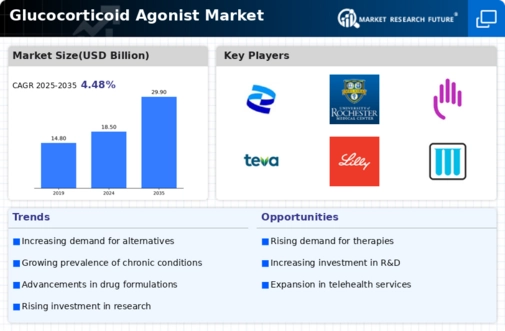Market Growth Projections
The Global Glucocorticoid Agonist Market Industry is projected to experience substantial growth, with estimates indicating a market size of 18.5 USD Billion in 2024 and a potential increase to 29.9 USD Billion by 2035. This growth trajectory reflects a compound annual growth rate of 4.48% from 2025 to 2035, driven by various factors such as rising chronic disease prevalence, advancements in drug formulations, and increased research activities. These projections highlight the market's resilience and adaptability in meeting the evolving healthcare landscape.
Advancements in Drug Formulations
Innovations in drug formulations are significantly impacting the Global Glucocorticoid Agonist Market Industry. The development of novel delivery systems, such as inhalers and injectables, enhances the efficacy and patient compliance of glucocorticoid therapies. For example, the introduction of combination inhalers has improved asthma management, leading to better patient outcomes. These advancements not only cater to patient needs but also drive market growth, with projections indicating a market size of 29.9 USD Billion by 2035. This evolution in drug delivery is likely to sustain the market's upward trajectory.
Rising Prevalence of Chronic Diseases
The Global Glucocorticoid Agonist Market Industry is experiencing growth due to the increasing prevalence of chronic diseases such as asthma, rheumatoid arthritis, and inflammatory bowel disease. As these conditions become more common, the demand for effective treatment options rises. For instance, the World Health Organization indicates that asthma affects over 300 million people globally, necessitating the use of glucocorticoids for management. This trend is projected to contribute to the market's expansion, with a valuation of 18.5 USD Billion in 2024, reflecting a growing need for glucocorticoid therapies.
Growing Awareness of Treatment Options
There is a notable increase in awareness regarding treatment options available for chronic inflammatory conditions, which is positively influencing the Global Glucocorticoid Agonist Market Industry. Educational initiatives by healthcare organizations and patient advocacy groups are informing patients about the benefits and risks associated with glucocorticoid therapies. This heightened awareness is likely to lead to increased patient consultations and prescriptions, thereby boosting market demand. As patients become more informed, the market is expected to see a steady rise, contributing to its projected growth in the coming years.
Increasing Research and Development Activities
The Global Glucocorticoid Agonist Market Industry benefits from heightened research and development activities aimed at discovering new glucocorticoid compounds and improving existing therapies. Pharmaceutical companies are investing significantly in R&D to explore the potential of glucocorticoids in treating various conditions beyond traditional uses. This focus on innovation is expected to yield new treatment options, thereby expanding the market. The anticipated compound annual growth rate of 4.48% from 2025 to 2035 underscores the importance of R&D in driving market dynamics and meeting evolving healthcare needs.
Regulatory Support for Glucocorticoid Therapies
Regulatory bodies are increasingly supportive of glucocorticoid therapies, which is fostering growth in the Global Glucocorticoid Agonist Market Industry. Streamlined approval processes for new glucocorticoid formulations and indications are encouraging pharmaceutical companies to invest in this sector. For instance, recent approvals for novel glucocorticoid treatments have expanded the therapeutic landscape, making these medications more accessible to patients. This regulatory environment is conducive to market expansion, as it not only facilitates innovation but also enhances patient access to essential therapies.

























Leave a Comment